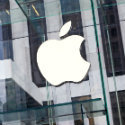Famous for iPhones and other expensive gadgets, Apple could become increasingly dependent on its fast-growing services business while the pandemic lasts.

Stockpiling of toilet paper and other household necessities has been a feature of the COVID-19 pandemic, as people go into survivalist mode. But stockpiling of Apple's luxury toys?
"We've seen an uptick across the board," said Apple CEO Tim Cook about late-April sales. "A part of it is probably the consumer behavior of knowing this is going to go on for a little while longer and getting some devices and so forth lined up to work at home more."
Notwithstanding this white-collar stampede for Apple's overpriced trinkets, selling iPhones is not easy when factories and shops are closed in one of your largest markets and manufacturing outposts. Predictably enough, China's lockdown in the January-to-March quarter took a juicy bite out of Apple's hardware revenues. Top-line growth was mainly thanks to its vibrant services business. Apple will need that more than ever as the pandemic lingers.
Headline sales at the California company edged up 0.5%, to $58.3 billion, compared with the year-earlier quarter. Net profit dipped 3%, to roughly $11.2 billion, after a spending splurge on research and development that could pay off as other companies tighten their budgets. The slight growth in revenues came despite a 7% drop in sales of Apple's most popular gadget, to just shy of $29 billion. A regional breakdown identifies the main culprit as China, where sales of all products and services fell by $763 million, to about $9.5 billion.
"We saw a strong January, and then a significantly reduced demand in February as the shelter-in-place orders and the lockdowns went into effect in China and the stores closed," said Tim Cook during a phone call with analysts.
Lockdowns posed no apparent obstacle to services growth, though. Cook hailed an "all-time record" as sales rose 16.5%, to about $13.3 billion. Stuck in their homes, customers piled into Apple's lineup of music, TV shows and games. "This business is growing and is a reflection of our enduring large and growing installed base," said Cook. "We expect to meet our longstanding goal of doubling our fiscal 2016 services revenue in 2020."
Achieve that, and Apple would report about $48.7 billion in revenues at its services business, up from $46.3 billion last year. Even if product sales remain stable, at the 2019 level, this would make services responsible for about 19% of total revenues, up from just 11% in 2016. But the actual figure could end up higher. In the recent quarter, around 23% of Apple's revenues came from the services business as product sales fell.
Apple's main worry for its current fiscal third quarter is outside of China, where lockdowns remain in force. Cook's upbeat assessment of late-April demand leads him to think iPad and Mac sales will grow this quarter, after they fell 6% in the second, to about $9.7 billion. But he has scrapped any revenue guidance for this quarter because of the current "uncertainty."
On the hardware side, it is hard to imagine business will not suffer in the Americas and Europe, Apple's two largest regional markets, judging by China's experience. Europe, in particular, was a bright spot for Apple between January and March, with sales up 9%, to roughly $14.3 billion. But European lockdowns were in effect only for the tail end of this quarter. Restrictions are either still in force or being slowly eased. The Economist newspaper is warning about a "90% economy" as demand fails to make a full recovery.
Want to know more about 5G? Check out our dedicated 5G content channel here on Light Reading.
Before the COVID-19 pandemic, a services shift made sense for Apple because device replacement cycles were lengthening. They are unlikely to shorten while shops remain closed or nervous consumers simply choose to avoid the high street. Some 30 million Americans have now signed on for unemployment benefits, and household budgets are being squeezed in the US and Europe. A company selling high-priced electronics equipment cannot expect to go unscathed. Apple's best hope is that its services business can mitigate the damage.
It should certainly help to protect profitability. At the product business, Apple's gross margin shrank by 3.8 percentage points sequentially, to 30.3%, in the second quarter. "This drop was more pronounced than under normal circumstances due to the COVID-19 impact," said Luca Maestri, Apple's chief financial officer. By contrast, the gross margin for services rose one percentage point, to 65.4%.
The obvious danger to Apple is that a slump in the gadgets market drags down the sale of services. Most of Apple's either work better on its own devices or remain unavailable to consumers without Apple hardware. Thanks to the large "installed base," however, a decline in product revenues did not obviously hinder the services business in the recent quarter. Apple, moreover, has gradually been opening up its software to other device makers. If gadget sales dry up, that shift may gather pace.
Related posts:
— Iain Morris, International Editor, Light Reading
About the Author(s)
You May Also Like











